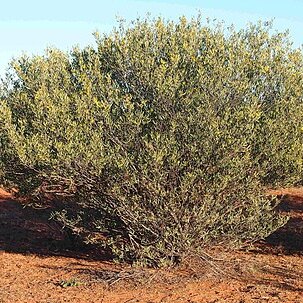Shrub or tree to 5 m high, spreading. Bark furrowed, usually grey or brown. Branchlets terete except at apices, grey or brownish, slightly scurfy, glabrous. Phyllodes narrowly elliptic to very narrowly elliptic, sometimes ±oblanceolate to narrowly oblanceolate, flat, straight or very slightly curved, 3–7.5 (–9) cm long, 4–15 (–25) mm wide, with obtuse and often mucronulate apices, coriaceous, grey-or blue-green, glabrous, resinous when young, very finely multistriate, non-anastomosing, sometimes with 1–3 veins slightly more prominent; gland ±basal. Peduncles 5–12 mm long, glabrous. Spikes 1 or 2 per upper axil, 1–2.5 cm long, dense, bright golden. Flowers 5-merous; calyx cupular, dissected to ⅓ of length, hairy mostly at base; corolla 1.3–2 mm long, 2–2.5 times as long as calyx. Pods oblong to narrowly oblong, flat, 2–7 cm long, 1–1.6 (–2) cm wide, chartaceous, finely transversely reticulate, glabrous, often slightly resinous. Seeds transverse to slightly oblique.
More
An evergreen spreading shrub. It grows to 3-4 m high and 2-3 m across. The stem is smooth, slender and bends easily. It is upright and with many branches. The bark is grey and becomes rough. The leaves (phyllodes) are stiff and broad. They are grey green. They are 5-10 cm long and 0.5-1.5 cm across. They have a blunt end and are slightly curved. There are 3 clear veins running along the leaf. The young growth is sticky. The flowers are golden rods. They are 2-4 cm long. They occur singly. The pods are 3-6 cm long and 1-1.5 cm across. They are flat, brown and sticky. There are 7-11 seeds per pod and they are 3-4 mm long. They are dark brown when ripe.
It is widespread in central Australia. It requires well drained soil. It can grow in part or full sunlight. It can withstand some drought and frost and grows in semi arid areas. It is often in limestone areas. Hot fires can kill it but it can re-shoot after cool fires in winter. It can grow in arid places.
More
Widely distributed in arid areas, where it occurs usually on stony hillsides or in coarse textured alluvial soils; often abundant in mulga woodlands on red sandy loam plains. Often found along seasonal watercourses.
Widely distributed in arid areas, where it occurs usually on stony hillsides or in coarse textured alluvial soils; often abundant in mulga woodlands on red sandy loam plains. Often found along seasonal watercourses.
Widely distributed in arid areas, where it occurs usually on stony hillsides or in coarse textured alluvial soils; often abundant in mulga woodlands on red sandy loam plains.


